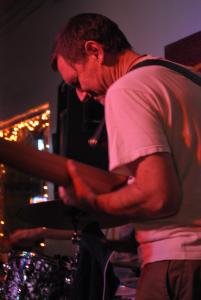Contrabassguitarist-composer Steuart Liebig has had a varied "non-career" in music. Hearing Renaissance vocal music alongside 20th-century classics and jazz at an early age and then later hearing some of the cutting-edge rock music of 1960s Los Angeles and many traveling blues bands at the legendary Ash Grove probably started him on a path that would include many different types of music. Taking up the electric bass in his early teens, his first playing experiences were, like many of his generation, involved in the rock and blues worlds. In high school he was introduced to jazz, though he often found himself bored with many of the mainstream sounds presented to him and started to search out more "exotic" strains of improvised music. In his early college days, he was lucky enough to find people who were sympathetic and with whom he would have long-lasting musical relationships. At the age of 19 he began a three-year stint playing rhythm guitar with soul-jazz pianist-singer Les McCann (playing on four albums). Feeling the need to develop a broader knowledge of classical music (and to get back to the bass!), he quit Les' band and returned to university, where he studied classical contrabass, music history and composition. During this period he also wrote for and played in original rock and jazz bands. After graduating he realized that the life of a symphony bassist was not going to do and decided to start a rock band. This band (BLOC) eventually went on to get the "fabled" major-label recording contract, put out an album and, like many rock bands, self-immolate. Luckily, Steuart had not put all of his musical eggs in one basket and had been playing with noted saxophonist-composer Julius Hemphill as well as various members of the Los Angeles improvised music community. He was also doing much self-study in "classical" composition. This self-study resulted in some 20 works, including a symphony, two string quartets, two string quintets, a piano quartet and several pieces for large orchestral forces. During the dissolution of BLOC, Steuart realized that his "calling" was not in line with having a personal involvement with the music-as-entertainment industry and decided to focus his energies on playing improvised music and composing. (Still, he found time to become a sideman for two promotional tours of singer-songwriter Michael Penn-which helped bankroll some of his creative music projects.) This decision eventually led to the formation of Quartetto Stig (violin, trumpet, drums, contrabassguitar), where Steuart was first able to integrate his compositional ideas with the needs of an improvisational group. The quartet had three well-received CDs on Nine Winds Records (Hommages Obliques, 1993; Lingua Oscura, 1995; Pienso Oculto, 1997). Being somewhat restless, Steuart disbanded the quartet and embarked on three more or less parallel lines of compositional investigation: Stigtette (flute, clarinet, trombone, contrabassguitar), which elaborates on some of the compositional ideas and techniques first explored in Quartetto Stig; Beutet (alto saxophone, chromatic harmonica, drums, contrabassguitar), which attempts to revisit American folk music (as exemplified by John Lee Hooker, Howlin' Wolf, Roscoe Holcombe, Hank Williams, etc.) through the prism of "avant-garde" jazz; and a free-jazz-based trio that uses skeletal themes as compositional "way stations" (with multi-reedist Vinny Golia and drummer Billy Mintz), which has two CDs on Cadence Jazz Records (No Train, 1999; Antipodes, 2001). Pomegranate (2001), which consists of four concerto-like vehicles for featured soloist and a seven-piece backing band, could probably be considered the apotheosis to date of the compositional ideas begun in Quartetto Stig. Besides the obvious challenge of trying to capture the personality of each featured soloist, there are some major differences between the four long-form pieces written for Pomegranate and the long-from pieces written for Quartetto Stig. Whereas the long-form pieces for the quartet are often episodic or based on classical forms (sonata allegro, rondo, theme and variations), the music on Pomegranate is based on the use of form by Stravinsky (and other 20th-century composers) and in the films of Peter Greenaway (The Pillow Book in particular). Another important distinction is that much of the music for the quartet was programmatic in nature-that is, the music was influenced by or based on a novel, a poem, a painting, a place, a person, etc.-the music for Pomegranate is, but for one small exception, non-programmatic. In addition to Stigtette and Beutet, Steuart is writing material for an improvising chamber group, Minim, developing literature for solo contrabassguitar, and continues to conceptualize and write long-form pieces for Kammerstig, the same group that performs on Pomegranate.Besides the compositional work discussed above, Steuart often plays in the groups of guitarist G.E. Stinson, drummer-percussionist Alex Cline, drummer-vibraphonist Gregg Bendian and trombonist Scot Ray; in the improvising collectives Bone Structure (Gregg Bendian, violinist Jeff Gauthier, Steuart Liebig, G.E. Stinson) and L. Stinkbug (drummer Scott Amendola, guitarist Nels Cline, Steuart Liebig, G.E. Stinson); and in improvising duos with Jeff Kaiser (trumpet, voice, electronics) and Anna Homler (voice, toys). He uses fretted and fretless Fodera contrabassguitars as well as Fodera roundwound strings (for Bb and Eb contrabassguitars) and Thomastik-Infeld Jazz Flats strings (for C contrabassguitars). Steuart lives in Culver City, California, with his wife, ceramist Leslie Rosdol, and their twin children, Anya and Aron.


